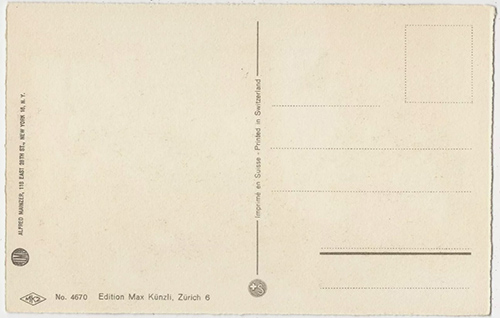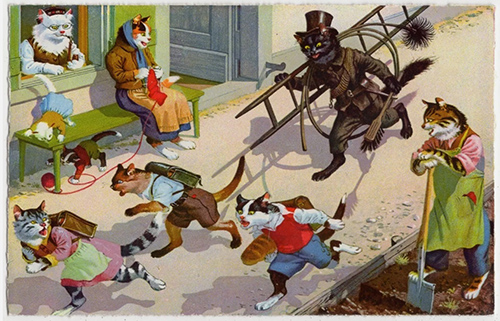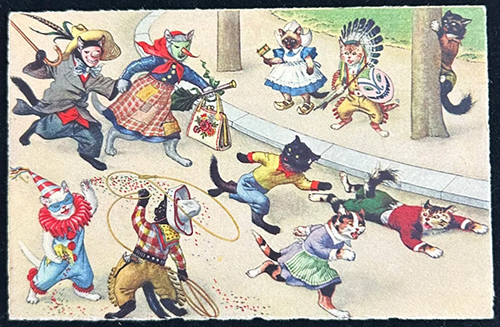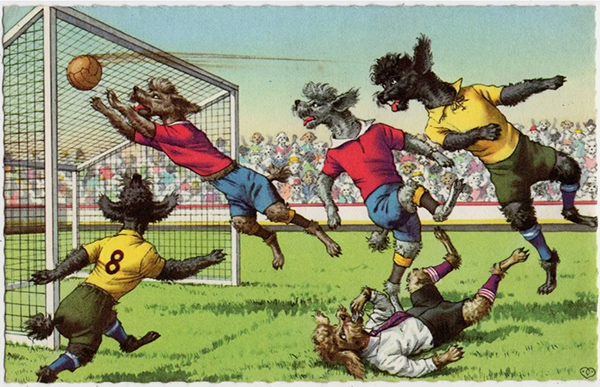A fresh-faced young couple leaves church with their adorable, wide-eyed baby after christening. A large family sits down to dinner, only to be disturbed when one irate youngster goes after a sibling over the table. In a hairdressing salon, Mother gets her nails done while her hair sets under the dryer — all while her feral kiddos attack each other on the floor beside her.
These scenes might seem like innocuous — even dull — slices of everyday life. But, what if our main characters in all of these scenes aren’t actually people living out their daily lives, but… cats? Cats in fabulous 1940s and ’50s fashions. Cats with jobs and husbands and adorably mischievous kittens forever causing a stir. Suddenly, suburbia isn’t quite so dull. Thanks to Mainzer Dressed Cat Postcards, these scenes and dozens more are brought to life with vivid color and hilarious detail.
The creator of these fabulous felines is not actually Alfred Mainzer, however. Instead, Swiss painter Eugen Hartung (1897 – 1973) was the artist responsible for the highly collectible line of postcards now known as Mainzer Cat Postcards. His cards were first published by Max Kunzli in Switzerland before the line was picked up by Alfred Mainzer, a New York-based publisher, in the 1940s.
Mainzer Dressed Cat Postcards by the Numbers
4670 – 4680
Most of Hartung’s cards, whether published by Kunzli or Mainzer, have 4-digit numbers on the back beginning with the number 4. These cards were numbered in ascending order over time, which means the earliest series begins with 4670. That card shows a young student in trouble with his schoolmaster, while his fellow students cause chaos in the background.

For the line of postcards numbered 4670 to 4680, the images are centered around daily life in the 1930s. There are multiple schoolyard scenes, including a brawl between kittens during recess (4671), a kitten choir (4673), and a home economics class (4675). The others in this line show a soccer match, a hiking outing complete with a resplendent kitten flag, and the inevitable chaos of home life with small kittens — a theme that continues throughout Hartung’s work.
The earliest printing of this card has a high rag content, vivid coloring, and on the back, the publishing information is listed as Max Kunzli, Zurich 6; Printed in Switzerland. In this early edition, there is no publishing information from Alfred Mainzer. This print run is hard to find, however. Much more common is the Mainzer run with the same publishing information and Mainzer’s imprint along the left edge (seen below). In this later print run, the Mainzer address is 118 East 26th Street, New York NY. In the excellent article “Mainzer Dressed Cats Began as Whimsical But Odd Postcards” on the website Bohemian Cats, this address is listed as the earliest used by Mainzer Publishing, thus putting the date of the printing at pre-1955. The fact that it was printed in Switzerland, however, indicates that the print run was likely the early 1940s.

In terms of value, any Kunzli postcards that do not have the Alfred Mainzer publishing imprint are older, more rare, and thus more valuable.
Mainzer Dressed Cats
4695 – 4774
The next series of numbered postcards that appear to have been designed and published pre-Mainzer begin with number 4695. Numbers 4695 – 4700 are pretty straightforward, with the earliest printings echoing those of the previous series. In these, Max Kunzli is indicated as the publisher, and the cards were printed in Switzerland. There is a high rag content, a bit less detail, and duller coloring than later cards. The earliest editions may or may not have scalloped edges. Alfred Mainzer’s imprint is not shown in these first printings. Again, the subject matter is daily life in the 1930s and ’40s: swimming in the lake (4695), leap frog on the playground (4696), and other schoolyard antics. Number 4700, one of the more sought-after cards, shows kittens racing down the street with a dusty chimney sweep following behind:


Life gets complicated with 4701, however, as Mainzer reused the same numbers for later postcards. Thus, number 4701 is associated with (1) happily wedded cats in a carriage pulled by poodles:

and (2) a very surprised Mom and kittens who find rats in their spooky root cellar:

The first card to be published with this number was the Mainzer wedding, and the root cellar was later released under the number 4852. This confusing duplicate numbering situation continues sporadically throughout the 4700s, particularly 4701 – 4709 and the 4720s, ’30s, ’40s, and ’50s. Complicating the issue even further is the fact that some of these numbers are used not twice but three times(!), and many of these images were re-released with a different number later on. Perhaps needless to say, any of the cards with Kunzli publishing information on the back (even with Mainzer’s insignia as well) are older and harder to find than those later reprints with just the Mainzer insignia.
Among the most collectible Mainzer cat postcards is this early Hartung work, Number 4738. It shows trick-or-treating kittens out on Halloween:

The detail on this card isn’t as fine as some of the others, but the masked demon cats chasing terrified kittens down the street are not to be missed.
Mainzer Dressed Cats
4850 – 4998
Thankfully, most of the numbering confusion ends with the series beginning with number 4850 — with the exception of 4858, which inexplicably has three different postcards with the same number. At this point, Mainzer is the only publisher listed on the cards. These postcards were most likely printed between 1955 and 1977, with printing locations including Belgium, Spain, Turkey, and the U.S. The only real confusion with these cards is that some are re-releases of earlier images, but with a little attention this is fairly easily navigated. For collectors interested, there is an excellent resource with Mainzer postcards broken down by number and thumbnail image as well as topic at this website.
The color is brighter, the detail finer in these later Hartung works. In addition to these changes, you might notice a shift in content as well. Fashion, of course, is a great way to track changes over time, but Hartung’s homage to the space race of the mid-1960s and the U.S. moon landing of 1969 (or the Soviet moon landing of 1966) is perhaps the most topical of his postcards. This card shows several cats in skirts waving flags as they greet two astronauts in a rocket setting down on the moon. Presumably the be-skirted cats are…aliens from the moon? Unclear. Either way, this Hartung work and one of a teacher in class teaching students about rocket science (number 4965) demonstrate the world’s obsession with space exploration in the 1960s.
Perhaps even more interestingly, Hartung’s dressed cat postcards track the shifting role of women in society between the 1940s and the 1960s. While early Kunzli/Hartung postcards only show lady cats outside the home as nurses or teachers, that shifts in the Mainzer cards beginning with 4860. There, we see a well-dressed Mom cat returning home to find her wild kittens creating chaos in the bath. Throughout this series, fashionably dressed lady cats are seen out shopping together — with or without their youngsters. Most scandalously, number 4953 shows scantily clad lady cats at a swim meet when one of the unfortunate damsels loses her bikini top. Naturally, a photographer is there to document the moment.

Mainzer Dressed Cats (and Dogs and Mice)
Coloprint B Specials
In addition to the multitude of postcards listed above, there are a few limited numbered sets released as “Coloprint B Specials.” These include a set numbered 2263/1 – 2263/6 of anthropomorphic mice living their best lives (including mouse ballerinas, kid mice helping Mom with chores around the house, and roller skating mice in the park). There is also a very rare winter-themed Coloprint B series featuring wintery cats, of which I have only been able to identify 2267/3 and 2267/6 — there may or may not be more in this series, but that is unknown at this time. Series 2270/1 – 2270/5 features Hartung’s canine heroes doing extraordinary things.

Clearly, Hartung’s art work in these amazing postcards is one of the major reasons their appeal has endured for so long. The attention to detail, enthusiastic subjects, and a clear element of action and suspense might also explain why Hartung’s dressed cats have been loved by so many for so long. But beyond that, the cards speak to a simpler time in the most romantic of ways — kind of like watching reruns of Leave It to Beaver, but with adorable cats and fewer problematic plotlines. Rather than belaboring the issues inherent in these scenes, Hartung succeeds in capturing a simple snapshot of humanity: a nurse handing the baby to its new mother while the rest of the family looks on; family portraits and go-cart races and chaotic family dinners. Each scene evokes a sense of nostalgia in viewers, yes, but the fact that these images are fantasy — they are, after all, bicycling cats and roller skating mice — creates just enough distance to keep generations of Mainzer-Hartung dressed cat fans coming back for more.



